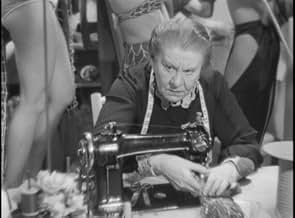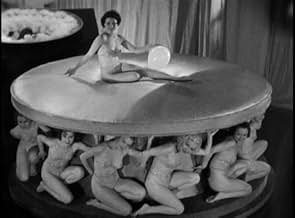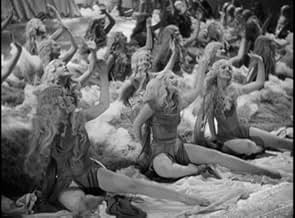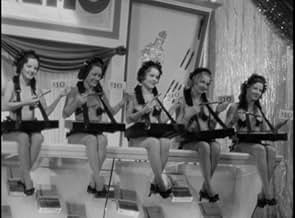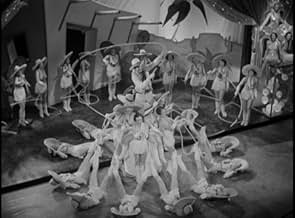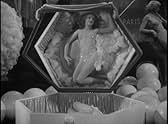Ajouter une intrigue dans votre langueA homicide detective with an eye for the ladies, investigating a murder in Earl Carroll's Vanities, allows the music revue to continue during the investigation.A homicide detective with an eye for the ladies, investigating a murder in Earl Carroll's Vanities, allows the music revue to continue during the investigation.A homicide detective with an eye for the ladies, investigating a murder in Earl Carroll's Vanities, allows the music revue to continue during the investigation.
Charles Middleton
- Homer Boothby
- (as Charles B. Middleton)
Ernestine Anderson
- Earl Carroll Girl
- (uncredited)
Lona Andre
- Lona - Earl Carroll Girl
- (uncredited)
William Arnold
- Treasurer
- (uncredited)
Lucille Ball
- Earl Carroll Girl
- (uncredited)
Histoire
Le saviez-vous
- AnecdotesMany of the Earl Carroll Girls featured in the film were authentic cast members from Carroll's stage show, which ran from September 12th to November, 1933, at the New Amsterdam Theatre, and at the Majestic Theatre from November 6th, 1933 to March 10th, 1934. These cast members were brought out to Hollywood from New York especially for this film, and many stayed to pursue film careers.
- GaffesWhen the body of the woman on the catwalk is turned on her back, you can see the actress' chest rise and fall as she takes a breath.
- Citations
[last lines]
Jack Ellery: Nancy, what shall I do?
Nancy: Oh, Mr. Ellery!
Jack Ellery: C'mon, let's do it.
- ConnexionsEdited into The Big Broadcast of 1937 (1936)
- Bandes originalesEbony Rhapsody
(uncredited)
by Arthur Johnston and Sam Coslow
Sung by Carl Brisson, Kitty Carlisle and Gertrude Michael
Commentaire en vedette
Earl Carroll's MURDER AT THE VANITIES (Paramount, 1934), directed by Mitchell Leisen, from the stage work by Earl Carroll and Rufus King, marked the studio's contribution to the stage musical of the precode era. Almost in the league as Warner Brothers' WONDER BAR (1934), with plot set in a single night revolving around an handful of sinful characters, VANITIES contains its own assortment of odd characters, great interplay between Jack Oakie and Victor McLaglen, risqué dialog and semi-nude chorines listed in the opening credits as "The Most Beautiful Girls in the World," makes this particular production something to consider.
Producer Earl Carroll is ill and unable to attend the opening night of his Vanities, which leaves Jack Ellery (Jack Oakie), former reporter turned stage director, in charge. Eric Lander (Carl Brisson) and Anne Ward (Kitty Carlisle), the show's leading couple, plan on getting married after the performance, much to the dismay of temperamental blues singer, Rita Ross (Gertrude Michael), who wants Eric for herself and will stop at nothing to get him. Before the curtain goes up, Anne finds her life being threatened by falling props and sandbags that nearly miss her, causing Ellery to notify his friendly rival, Police Lieutenant Bill Murdock (Victor McLaglen) to investigate. Sadie Evans (Gail Patrick), a female investigator hired by Eric, arrives to return valuable information stolen from him by Rita. Because Miss Evans has learned more than she should, her life is threatened by Helene Smith (Jessie Ralph), a wardrobe woman with a mysterious past of her own. During a performance, blood is felt dripping upon a chorus girl, causing her to scream and Murdock to trace the dripping blood to the body of Sadie Evans, stabbed by a large pin. When Rita threatens to expose what she knows about Eric in Vienna, she, too is murdered by a mysterious bullet. The show goes on as Ellery and Murdock work together in hope of rounding up the usual suspects.
Other members of the cast include Charles Middleton as Shakespearean actor Homer Boothby; Donald Meek as Doctor J.T. Saunders; and Barbara Fritchie as Viven. Notable performances go out to the comic-strip appearance of Dorothy Stickney as Norma Watson, Rita's abused maid; and Toby Wing as Nancy, the giggly blonde wanting desperately some time alone with Jack Ellery, who constantly casts her aside until later. Kitty Carlisle, best known for her role opposite the Marx Brothers in A NIGHT AT THE OPERA (MGM, 1935), and as TV's panelist on the 1960-70s quiz show, TO TELL THE TRUTH, performs well in her motion picture debut, especially opposite Carl Brisson who, at times, resembles Carlisle's NIGHT AT THE OPERA love interest, Allan Jones, but minus the Danish accent.
A well-crafted murder mystery with an abundance of fine tunes by Arthur Johnson, Sam Coslow and Johnny Burke, include: "Cocktails for Two" (sung by Carl Brisson); "Where Do They Come From and Where Do They Go?" (sung by Kitty Carlisle); "Lovely One" (sung by male chorus); "Where Do They Come From and Where Do They Go?" (concluded by Carlisle); "Live and Love Tonight" (sung by Brisson); "Sweet Marijuana" (sung by Gertrude Michael); "Cradle Me With a Hatcha Lullaby" (instrumentally performed by male dancers); "The Rape of the Rhapsody" (sung by Brisson, orchestrated by Duke Ellington and his Band; reprized by Kitty Carlisle); "Doing the Ebony Rhapsody" (sung by Gertrude Michael); "Cocktails for Two" (sung by Brisson, chorus); and Finale: "Live and Love Tonight," "Sweet Marijuana" and "Cocktails for Two."
While "Cocktails for Two" became a song hit that that was later spoofed in the 1940s by band-leader Spike Jones, "Live and Love Tonight" is actually one of the better and nicer tunes helped by its production number treatment set on an island with Brisson as the sole male surrounded by under-dressed island girls (Carlisle included) and others using ostrich feathers as water waves. Gertrude Michael's rendition to "Sweet Marijuana" surrounded by dancing shadows, appears to be the sort of tune 35 years ahead of its time, fitting more into the 1960s hippie generation than 1934. Franz Liszt's "Second Hungarian Rhapsody," the longest of the production numbers, is an interesting attempt turning slow tempo classical composition to upbeat jazzy orchestration with Duke Ellington at the piano. Larry Ceballos and LeRoy Prinz are credited for their impressive (or suggestive) choreography.
Rarely televised possibly due to its subject matter that make precode movies all the more worth seeing today, MURDER AT THE VANITIES, having been one of an assortment of rare classic films aired Sunday nights (1974-75) on Hartford, Connecticut's WFSB, Channel 3, did become available on home video in the 1980s (retail price: $59.95) and finally DVD in 2009. Its availability should add to the rediscovery of buried treasures such as this. (***)
Producer Earl Carroll is ill and unable to attend the opening night of his Vanities, which leaves Jack Ellery (Jack Oakie), former reporter turned stage director, in charge. Eric Lander (Carl Brisson) and Anne Ward (Kitty Carlisle), the show's leading couple, plan on getting married after the performance, much to the dismay of temperamental blues singer, Rita Ross (Gertrude Michael), who wants Eric for herself and will stop at nothing to get him. Before the curtain goes up, Anne finds her life being threatened by falling props and sandbags that nearly miss her, causing Ellery to notify his friendly rival, Police Lieutenant Bill Murdock (Victor McLaglen) to investigate. Sadie Evans (Gail Patrick), a female investigator hired by Eric, arrives to return valuable information stolen from him by Rita. Because Miss Evans has learned more than she should, her life is threatened by Helene Smith (Jessie Ralph), a wardrobe woman with a mysterious past of her own. During a performance, blood is felt dripping upon a chorus girl, causing her to scream and Murdock to trace the dripping blood to the body of Sadie Evans, stabbed by a large pin. When Rita threatens to expose what she knows about Eric in Vienna, she, too is murdered by a mysterious bullet. The show goes on as Ellery and Murdock work together in hope of rounding up the usual suspects.
Other members of the cast include Charles Middleton as Shakespearean actor Homer Boothby; Donald Meek as Doctor J.T. Saunders; and Barbara Fritchie as Viven. Notable performances go out to the comic-strip appearance of Dorothy Stickney as Norma Watson, Rita's abused maid; and Toby Wing as Nancy, the giggly blonde wanting desperately some time alone with Jack Ellery, who constantly casts her aside until later. Kitty Carlisle, best known for her role opposite the Marx Brothers in A NIGHT AT THE OPERA (MGM, 1935), and as TV's panelist on the 1960-70s quiz show, TO TELL THE TRUTH, performs well in her motion picture debut, especially opposite Carl Brisson who, at times, resembles Carlisle's NIGHT AT THE OPERA love interest, Allan Jones, but minus the Danish accent.
A well-crafted murder mystery with an abundance of fine tunes by Arthur Johnson, Sam Coslow and Johnny Burke, include: "Cocktails for Two" (sung by Carl Brisson); "Where Do They Come From and Where Do They Go?" (sung by Kitty Carlisle); "Lovely One" (sung by male chorus); "Where Do They Come From and Where Do They Go?" (concluded by Carlisle); "Live and Love Tonight" (sung by Brisson); "Sweet Marijuana" (sung by Gertrude Michael); "Cradle Me With a Hatcha Lullaby" (instrumentally performed by male dancers); "The Rape of the Rhapsody" (sung by Brisson, orchestrated by Duke Ellington and his Band; reprized by Kitty Carlisle); "Doing the Ebony Rhapsody" (sung by Gertrude Michael); "Cocktails for Two" (sung by Brisson, chorus); and Finale: "Live and Love Tonight," "Sweet Marijuana" and "Cocktails for Two."
While "Cocktails for Two" became a song hit that that was later spoofed in the 1940s by band-leader Spike Jones, "Live and Love Tonight" is actually one of the better and nicer tunes helped by its production number treatment set on an island with Brisson as the sole male surrounded by under-dressed island girls (Carlisle included) and others using ostrich feathers as water waves. Gertrude Michael's rendition to "Sweet Marijuana" surrounded by dancing shadows, appears to be the sort of tune 35 years ahead of its time, fitting more into the 1960s hippie generation than 1934. Franz Liszt's "Second Hungarian Rhapsody," the longest of the production numbers, is an interesting attempt turning slow tempo classical composition to upbeat jazzy orchestration with Duke Ellington at the piano. Larry Ceballos and LeRoy Prinz are credited for their impressive (or suggestive) choreography.
Rarely televised possibly due to its subject matter that make precode movies all the more worth seeing today, MURDER AT THE VANITIES, having been one of an assortment of rare classic films aired Sunday nights (1974-75) on Hartford, Connecticut's WFSB, Channel 3, did become available on home video in the 1980s (retail price: $59.95) and finally DVD in 2009. Its availability should add to the rediscovery of buried treasures such as this. (***)
- lugonian
- 13 mars 2009
- Lien permanent
Meilleurs choix
Connectez-vous pour évaluer et surveiller les recommandations personnalisées
- How long is Murder at the Vanities?Propulsé par Alexa
Détails
- Date de sortie
- Pays d’origine
- Langue
- Aussi connu sous le nom de
- Tajne Varijetea
- Lieux de tournage
- société de production
- Consultez plus de crédits d'entreprise sur IMDbPro
- Durée1 heure 29 minutes
- Couleur
- Rapport de forme
- 1.37 : 1
Contribuer à cette page
Suggérer une modification ou ajouter du contenu manquant

Lacune principale
By what name was Murder at the Vanities (1934) officially released in India in English?
Répondre

